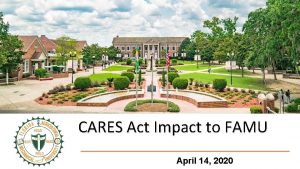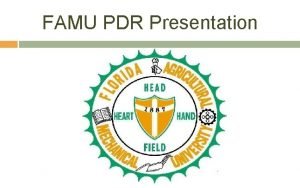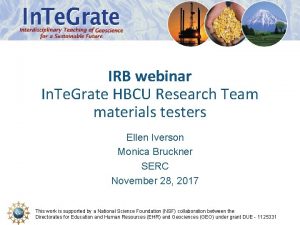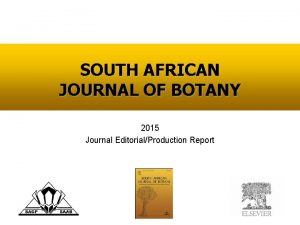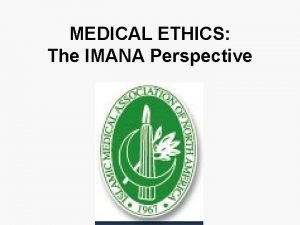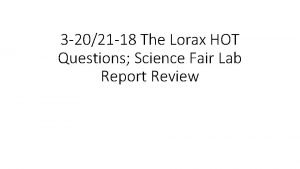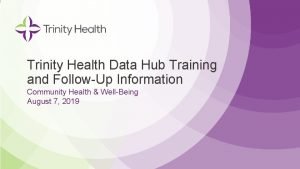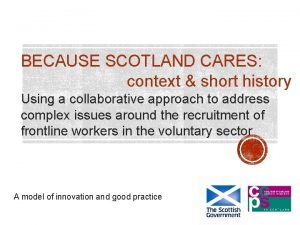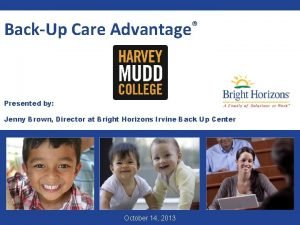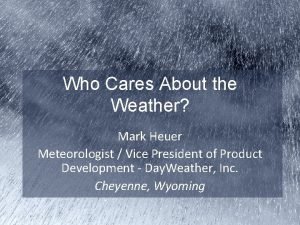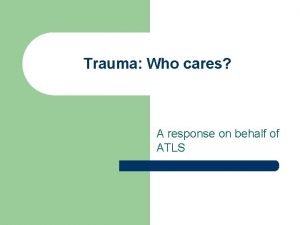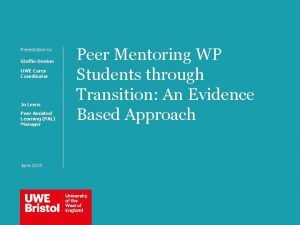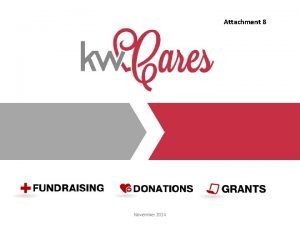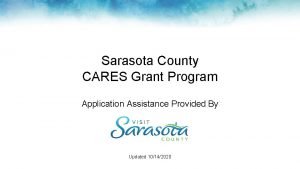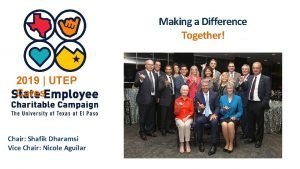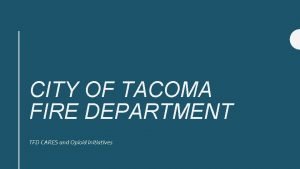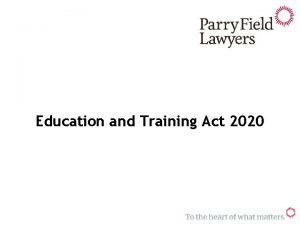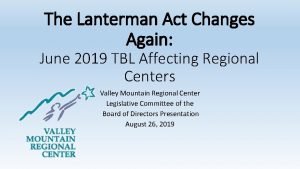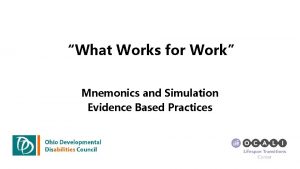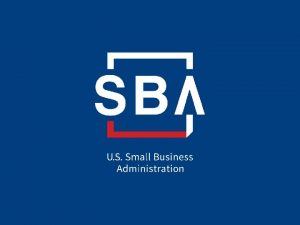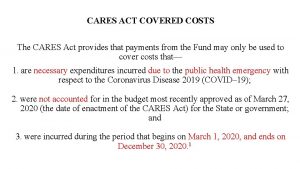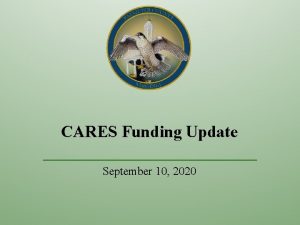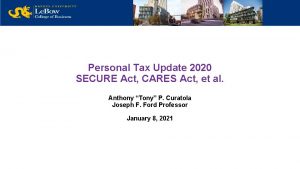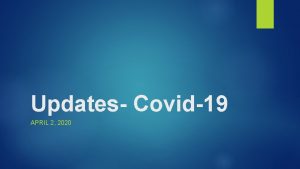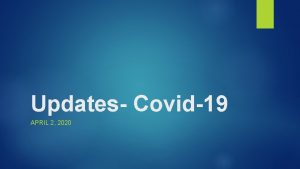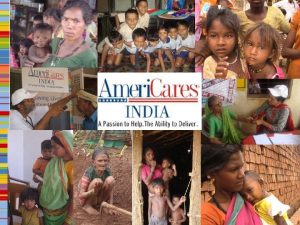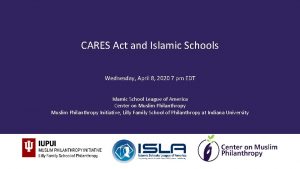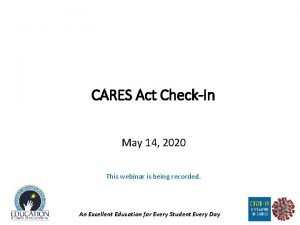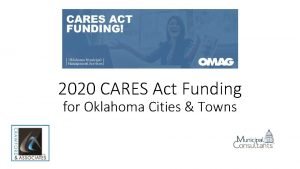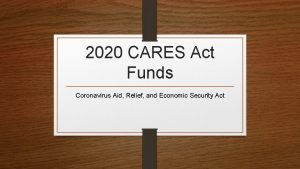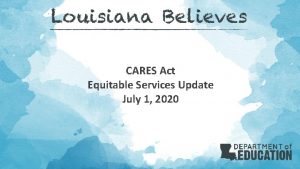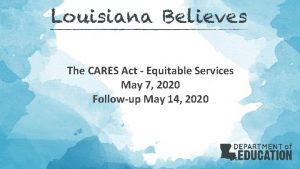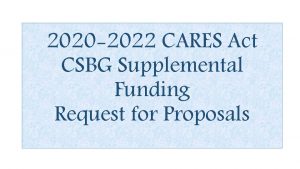CARES Act Impact to FAMU April 14 2020





























- Slides: 29

CARES Act Impact to FAMU April 14, 2020

High Level Overview of CARES Act The Coronavirus Aid, Relief, and Economic Security Act (CARES Act) • Bipartisan legislation passed on March 27, 2020 • $2 trillion in emergency appropriations and policies designed to alleviate economic hardship due to COVID-19 • Read the full law here Highly Complex Legislation The CARES Act is one of the most complicated and far reaching pieces of legislation ever passed, impacting countless regulations and industry sectors. Source: EAB (https: //eab. com/) Pending Regulatory Guidance Relief but Not Salvation More Help to Come? Broad legislation leaves higher ed institutions awaiting further clarification from the Dept of Education on how to interpret policy and make regulations. Most higher education experts agree that the package accounts for less than half of what the industry needs to navigate this crisis. Congress has signaled willingness to provide additional funds in the coming months should the situation merit it.

Higher Education’s Stimulus Funding Education Stabilization Appropriation Of the $2 T relief package, $30. 75 B is dedicated to the education sector with $13 B going directly to K 12 Governor Education Relief Fund $2. 95 B available for governors to direct to higher education or K-12 Higher Education Emergency Relief Fund $14. 25 B devoted to helping higher ed institutions and students $12. 56 B awarded to each institution though formula (75% Pell recipient enrollment, 25% total inperson enrollment) FAMU Allocation Emergency Financial Aid Grants: $6, 525, 663 Total: $13, 051, 325 $331 M granted to institutions who have significant unmet need $1. 05 B dedicated emergency aid to HBCU and minority-serving institutions (MSIs) FAMU Allocation Award amount still unknown

Governor’s Education Relief Funds Point of Consideration 1 Fund Recipients 2 Fund Restrictions for Higher Education Governor Priority During the 2020 legislative session, the Governors focus was on increasing funding to K-12. Funds are eligible to be applied to K-12 and/or Higher Education at the discretion of the governor. Funds shall not be used to support capital projects, research and development, or tuition and fees paid by students. 3 Do. A Recommendations BOG/SUS Collaboration Highlight the financial needs of SUS institutions beyond what was received through the HERFs Funding Eligibility for Higher Education Florida must agree to maintain support for higher education in fiscal years 2020 and 2021 at least at the average level of support provided in fiscal years 2017, 2018, and 2019. Special Legislative Session Advocacy • • Assess fund ineligibility risk Develop advocacy plans

Higher Education Relief Funds (HERF) Two Statutory Categories of Fund Use 1 Emergency Student Financial Aid Grants (ESFAG) At least 50% of institution’s total funding must go to student aid, including • Targeted funds to help students' costs associated with campus closures and the shift to virtual instruction • Eligible expenses under a student’s cost of attendance (e. g. , food, housing, course materials, technology, healthcare, and childcare) 2 Institutional Discretion The remaining balance of funds can be used for most costs incurred by COVID-19, including the shift to online instruction • Excludes certain enrollment expenses, like payments to marketing vendors, and capital expenses associated with athletics facilities • Institutions are encouraged to maintain all staff on payroll, but they are not legally mandated to do so Points of Considerations Disbursement Speed Funds will be disbursed on two timelines with ESFA available Disbursement Mechanism ESFAG funds are being disbursed through the grants. gov portal Allowable use of Funds Limited guidance has been received from the Department of Education

Grants 1 Restrictions • Direct payment of grants to students • Schools cannot reimburse themselves for any costs or expenses 2 Requirements • Distribute funds promptly (1 year deadline) • Reporting Requirements (30 Days/45 Days): • How grants were distributed to students • Amount of each grant • Calculation used for each grant • Instructions/Directions given to students about grants • Continued payment of employees and contractors 3 Department of Ed Recommendations • Cap award amounts at the Federal Pell Grant maximum • Take into consideration student’s socioeconomic circumstances • Authorize Financial Aid Director to make adjustments on a case-by-case basis to exclude ESFAG from student’s expected family contributions

Grants Do. A Recommendations Grant Application Reimbursement Process Develop student grant application Disbursed through the mechanism used for financial aid refunds. Grant limit Cap at maximum Federal Pell Grant Amount for fiscal year 19 Reimbursement Schedule Category Limits Weekly until all grant funds are depleted or no new student grant applications are received. Consider setting additional limits for individual categories of costs Staffing Decisions Tracking Awards and Disbursements Based on projected losses and revenue develop staffing plan options • • Add ESFAGs to students financial aid awards for the semester in i. Rattler Note: FAMU can not deduct tuition owed from the grant award Reporting Develop internal dashboards and external reports

HERF: Institutional Discretionary Funds 1 Funds Use • To cover costs associated with significant changes to the delivery of instruction due to coronavirus 2 Do. A Recommendations Delivery Cost Identification Process to identify and categorize delivery costs already occurred Examples include: • Restrictions • Funds cannot be used for: • Contractors for pre-enrollment recruitment activities • Endowments • Capital outlays associated with facilities related to athletics • Sectarian instruction • Religious worship • Hardware (laptops, mobile hotspot devices) • • • Software VPN and Network Upgrades Remote Proctoring for Exams Long-Term Remote Learning Planning • Workgroup to identify future costs and needs associated with maintaining remote learning or a hybrid of remote learning through FY 20.

Education Policy Do. A Recommendations SEOG & FWS Impact Assessments Sec. 3503. Campus-based aid waivers • Waives the requirement that a participating institution of higher education provide a non. Federal share to match Federal funds provided to the institution for the Federal Supplemental Educational Opportunity Grant (SEOG) and Federal Work Study (FWS) programs • Allows an institution to transfer up to 100 percent of the institution’s unexpended allotment from FWS to SEOG (but not from SEOG to FWS). • • • Potential Cost Savings Impact to Students Impact to Enrollment Divisional FWS Survey • Sufficient work for students remotely in Fall • Reduce or eliminate FWS positions for the division

Education Policy Sec. 3504. Use of supplemental educational opportunity grants for emergency aid. • Allows an institution of higher education to reserve any amount of an institution’s allocation under SEOG for a fiscal year to award, in that fiscal year, emergency financial aid grants to assist undergraduate or graduate students for unexpected expenses and unmet financial need as the result of a qualifying emergency. Point of Consideration Stabilize Enrollment Opportunity • Use a portion of the SEOG grant money to create emergency financial aid grants, which can also be used for both unexpected costs and tuition. Do. A Recommendation Application Process • Develop criteria, application and review process for awarding SEOG emergency financial aid grants.

Education Policy Sec. 3505. Federal work-study during a qualifying emergency. • Allows an institution of higher education participating in FWS to make payments to workstudy students, for the period of time (not to exceed one academic year) in which affected students were unable to fulfill their work-study obligation for all or part of such academic year due to a qualifying emergency. Do. A Recommendation Continue FWS Payments • Continue to make payments to participating FWS students through the end of the 2019 -2020 academic year.

Education Policy Sec. 3506. Adjustment of subsidized loan usage limits. • Excludes from a student’s period of enrollment for purposes of loans made under the Federal direct loan program any semester (or the equivalent) that the student does not complete due to a qualifying emergency. Sec. 3507. Exclusion from Federal Pell Grant duration limit. • Excludes from a student’s Federal Pell Grant duration limit under any semester (or the equivalent) that the student does not complete due to a qualifying emergency. Do. A Recommendations Student Communication • A CARES act communication should be developed for students to break down key information to them, such as this. Term Completion Assessment • Determine how many students failed to complete Spring 2020 term.

Education Policy Sec. 3508. Institutional refunds and Federal student loan flexibility. • • Waives the institutional requirement with respect to the amount of grant or loan assistance (other than assistance received under FWS) to be returned under such section if a recipient of assistance under Title IV withdraws from the institution of higher education during the payment period or period of enrollment as a result of a qualifying emergency (waives institutional requirement with respect to R 2 T 4). Also waives the amounts that students are required to return with respect to Federal Pell Grants or other grant assistance if the student withdrew from the institution of higher education as a result of a qualifying emergency. Compliance Impacts Timely Return of R 2 T 4 • Alleviates risk of prior audit criticism for timely return of Title IV funds. Do. A Recommendations Refund • Determine if refunds are needed to students who withdrew and have already made repayment. Legal Opinion • Determine whether this applies to the whole Spring semester or the date CARES took effect.

Education Policy Sec. 3509. Satisfactory academic progress. • Allows an institution of higher education, as a result of a qualifying emergency, to exclude from the quantitative component of the SAP calculation any attempted credits that were not completed by such student without requiring an appeal by such student. Do. A Recommendation SAP Calculations • If the SAP calculations are currently automated by i. Rattler, then a process will need to be developed to integrate this directive.

Education Policy Sec. 3512. HBCU Capital Financing • The HBCU Capital Financing Program, authorized under the HEA, assists HBCUs in obtaining low-cost capital financing for campus maintenance and construction projects. • The CARES Act authorizes the Secretary of Education to grant a deferment during a qualifying emergency to an institution that has a loan under the program. • During the period of the deferment, the Secretary is required to pay the required principal and interest due. At the end of the deferment, the IHE is required to repay the Secretary for payments made on its behalf. Do. A Recommendations Deferment Opportunity Assess if deferring the payments will allow us to utilize those payment amounts for other critical University needs. • Loan Payment Requirement • Assess the University’s ability to continue to make required loan payments. Compliance with Loan Terms • An increased focus should be placed on loan term compliance requirements.

Education Policy Sec. 3513. Temporary relief for federal student loan borrowers. • Suspends all student loan borrower payments due for loans made under the Federal direct loan program and Federal family education loan program for 6 months and halt all interest accrual during that time. • Will consider each month for which a loan payment was suspended under this section as if the borrower of the loan had made a payment. • Suspends involuntary collections during this sixmonth period • Requires ED to provide notice to borrowers of actions taken in accordance with this section and provide at least 6 notices for when payments must resume. Do. A Recommendation CARES Communication • A communication should be developed for students, faculty, and staff to inform them of the impact of CARES Act on their student loan debt and payments.

Education Policy Sec. 3517 & 3518 Title III Flexibility • Allows institutions to put previously restricted funds directly to use in addressing the new challenges that our schools and their students face during the ongoing health emergency. • The CARES Act gives the Department of Education authority to waive certain eligibility, matching, time periods, and allotment requirements related to federal assistance to Higher Education Institutions. Student Veteran Education Benefits • No flexibility is included in the CARES ACT.

Tax and Business Policy Sec. 2204. Allowance of partial above the line deduction for charitable contributions • Allows partial above-the-line deduction for charitable contributions. • Permits individuals to deduct up to $300 of charitable contributions, whether they itemize their deductions or not for 2020. Sec. 2205. Modification of limitations on charitable contributions during 2020. • For individuals, the 50 percent of adjusted gross income limitation is suspended for 2020. • This provision also increases the limitation on deductions for contributions of food inventory from 15 percent to 25 percent. Do. A Recommendation Fundraising Communications • FAMU Foundation, Athletics, and Communications should work together to draft communications to inform our supporters and stakeholders to encourage more charitable giving.

Tax and Business Policy Sec. 2206. Exclusion for certain employer payments of student loans. • An employer may contribute up to $5, 250 annually toward an employee’s student loans, which would be excluded from the employee’s income. • The $5, 250 cap applies to both the new student loan repayment benefit as well as other educational assistance (e. g. , tuition, fees, books) provided by the employer under current law. • The provision applies to any student loan payments made by an employer on behalf of an employee after the date of enactment and before January 1, 2021. Do. A Recommendation Employee Tuition Waivers • Evaluate whether or not the employee tuition waivers are impacted by this particular exclusion for tax purposes.

Tax and Business Policy Sec. 2302. Delay of payment of employer payroll taxes. • Defers payment of employer payroll taxes through January 1, 2021, with 50 percent due by December 31, 2021 and the remaining 50 percent due by December 31, 2022. • Clarifies that an employer will be treated as having made timely deposits of applicable taxes during the deferral period if all such deposits are made not later than the applicable dates. Do. A Recommendation Deferment Assessment • If deferment is chosen, a plan should be developed to ensure payment can be made on required dates.

Tax and Business Policy FAMU does qualify for the following benefit under the CARES Act: • Federal Reserve Main Street Loans: will charge no more than a 2% interest rate and principal and interest payments will be deferred for one year. Borrowers must certify that the loan is necessary to support ongoing operations and that 90% of employees will be retained through September 30, 2020. Do. A Recommendation Deferment Assessment • A careful evaluation of the loan requirements and restrictions placed on the university should the university apply for such loans.

Tax and Business Policy Impact Unplanned Expense Paid Leave Tax Credit • FAMU is required to provide the expanded leave granted under the Families First Coronavirus Response Act (FFCRA) to employees. • The CARES Act does not expand the paid leave tax credit created in FFCRA to cover public universities and colleges, such as FAMU. • Additional unplanned expense for every leave granted under the FFCRA. Do. A Recommendation Tracking of COVID-19 Expense • Human Resources should track all paid leave taken under the Families First Coronavirus Response Act. This expense should be included in our COVID-19 expense totals. US House and Senate Advocacy • Advocate for the paid leave tax credits to be added for public universities in any future stimulus packages.

Tax and Business Policy Sec 1103 Entrepreneurial Development - $265 million • Provides grants for education, training, and advising to SBD Centers and WBC. These grants will help these businesses with: o Education, training, and advising relating to access to capital and business resiliency o Hazards and prevention of the transmission of COVID-19 and other communicable diseases o Effects of COVID-19 on the supply chains, distribution, and sale of products o Risk management practices. Do. A Recommendation Assessment of Small Business Partnerships • Assess what small businesses FAMU has associations with that the university can utilize this funding to provide support services. Development of Materials • Develop materials to facilitate funding initiatives.

Tax and Business Policy FAMU does not qualify for the following benefits under the CARES Act: • Employee Retention Tax Benefit: An employee retention tax credit will be available for 50 percent of the wages paid by employers to employees during the COVID-19 crisis. • Sec. 1102 -SBA Paycheck Protection Program (PPP): Loans that can be used for payroll support such as employee salaries, paid sick or medical leave, insurance premiums, and mortgage, rent, and utility payments.

Research Impact Research Disruption • No additional funds to cover university research disrupted by COVID-19 closures Research Opportunity • Opportunities may be available for faculty to apply for coronavirus specific research grants. Do. A Recommendation Tracking of COVID-19 Expense Division of Research should track disruption costs. If practical, this expense should be included in our COVID-19 loss totals. Research Deliverables Review • • Assess research deliverables and funding impacts from COVID-19

Other Provisions of Interest Points of Consideration Application Project SERV. • Under Safe Schools and Citizenship Education, $100 million allocated “to prevent, prepare for, and respond to coronavirus, domestically or internationally, to supplement funds otherwise available for Project SERV, including to help elementary, secondary and postsecondary schools clean and disinfect affected schools, and assist in counseling and distance learning and associated costs. ” • What is the process for applying for funds? Service Categories • What is the division of the funds between education levels and service categories? Do. A Recommendation Track Costs • Track associated costs with covered service categories. Monitoring Guidance • Monitor for additional guidance to address points of consideration mentioned above.

Other Provisions of Interest INSTITUTE OF MUSEUM AND LIBRARY SERVICES: $50 MILLION • To prevent, prepare for, and respond to coronavirus, to expand digital network access, purchase internet accessible devices, and provide technical support services. NATIONAL ENDOWMENT FOR THE HUMANITIES: $75 MILLION • Grants to provide continued access to cultural organizations and institutions of learning. NATIONAL ENDOWMENT FOR THE ARTS: $75 MILLION • Grants to provide continued access to cultural organizations and institutions of learning. Do. A Recommendation Assess Eligibility • Assess eligibility of University Libraries, Meek Eaton Black Archives, and other university programs under the associated funding.

CARES Act Sources • Association of Public & Land Grant Universities: https: //www. aplu. org/ • U. S. Department of Education: https: //www. ed. gov/ • EAB: https: //eab. com/

“At FAMU, Great Things are Happening Every Day!”
 Famu cares act
Famu cares act Famu pdr
Famu pdr Felicia warford
Felicia warford South african journal of botany impact factor
South african journal of botany impact factor Macbeth summary
Macbeth summary Gmcares
Gmcares No one cares
No one cares Is imana cares fake
Is imana cares fake If someone like you cares a whole awful lot
If someone like you cares a whole awful lot Cares rebar
Cares rebar Cares engagement network
Cares engagement network The lord cares
The lord cares Norfolk cares hotline
Norfolk cares hotline No one cares for my soul
No one cares for my soul Because scotland cares
Because scotland cares Backup care advantage
Backup care advantage Does jesus care when my heart is pained
Does jesus care when my heart is pained Mark heuer
Mark heuer Trauma who cares
Trauma who cares Uwe cares
Uwe cares Kw cares application
Kw cares application Do not become entangled in the affairs of this world
Do not become entangled in the affairs of this world Sarasota county cares grant
Sarasota county cares grant Utep cares
Utep cares Tacoma fire department calls
Tacoma fire department calls Education and training act 2020
Education and training act 2020 Imd tbl
Imd tbl On april 23 1564 william shakespeare was born
On april 23 1564 william shakespeare was born 23 april 1616
23 april 1616 30 days has september april june and november
30 days has september april june and november
